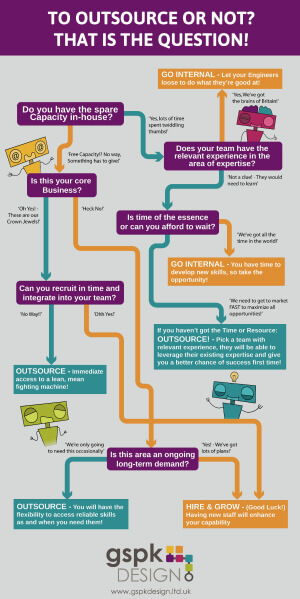A recent survey showed that less than 5% of internal development projects were completed on time, on budget and met all expectations. So why is it that we struggle to outsource? Surely it’s the right thing to do.
What is it that fundamentally drives us to hold on till the bitter end, refusing to give up and get the experts in to help? Don’t we seek medical help when we are unwell our unsure of our condition?
If we haven’t got the capability in-house or haven’t got the technical equipment or expertise, the decision to outsource is sometimes easier, but when there are more things to consider, it’s not always that simple.The question of whether to outsource or not to outsource becomes far more complex even though the stakes may be same.
It’s the same with any complex decision in life: the more possible solutions and variety of inputs into the decision the more our emotions get tied up in a knot, and the more our emotions get involved the more we procrastinate.
From what I’ve seen over the past years a there are a couple of things that really affect the decision as to whether we outsource or not and we should probably bear these in mind the next time we consider the question.
One major dilemma is when we have the skills in-house or some of the skills in-house – the decision seems to become more difficult the closer our skills match the project.
As a design house offering a full range of services, it’s always a difficult sell to a company that’s already got in-house capability; not impossible, but always difficult.
Ironically, it would seem that customers assign build projects quicker to the Far East, mainly Asia, where at best communication is eight hours old before you see it. Along with that your product is manufactured outside your normal control and likely shipped by sea, so until the product arrives at your door you’re not 100% sure it’s correct. How does the “hold on to design and procrastinate” fit in to that model where, at most, it’s a call and a short journey to be able to see and touch your electronics design?
It’s that logic that “we can do it in-house, so why pay someone else?” The problem we all know is that it’s not always the most sensible commercial decision to make to continue to develop a product in-house. With the clock ticking and product lifecycles getting shorter and shorter, the saying “time waits for no man” comes into its own and lead-times start to play a big part. It’s then that we need to be careful, and take this into consideration. Your team may have the way to complete, but do they have the will with everything else that’s going on? Can you afford anything else to slip, while at the same time can you afford not to commence with that new project idea?
The other thing that I’ve found that really affects the decision to outsource or not is how many stakeholders there are in the project. The more there are, the greater the reluctance to outsource. We become concerned that we will be judged on our decision, the fear creeps in that we may lose control, heightened by the worry about what happens if what we believe is meant to happen, doesn’t happen. What happens if the project fails or is late in someone else’s hands? Well, the good news is that, according to statistics, if you ran the project internally you would be very unlikely to finish on time anyway, so why not outsource?
If anything goes wrong, not that it would, at least you can blame someone else.
So with this in mind we thought we’d put together something that might help the decision process if you’re currently considering whether to outsource or not. See hear to download this infographic: To Outsource or Not


